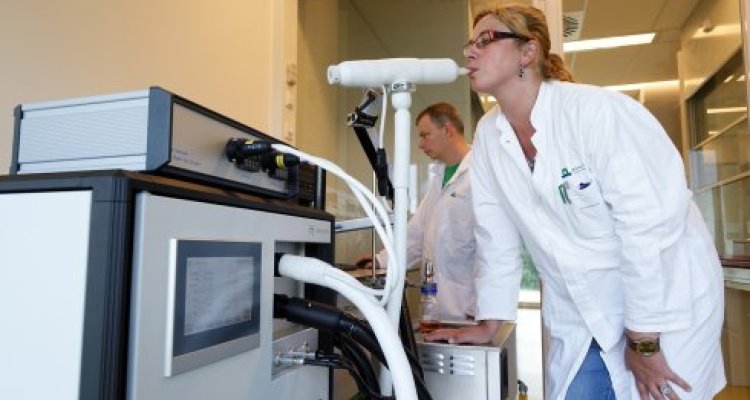
Nieuws
PTR-TOF-MS has an objective nose for volatile substances
Are you looking for a fast, objective and effective way to measure volatile substances? Then you should consider the PTR-TOF-MS: the Proton Transfer Reaction – quadrupole ion Time of Flight – Mass Spectrometer. This device analyses the volatile components in air with great accuracy.
The PTR-TOF-MS was purchased by CAT-AgroFood Shared Research Facilities and has been operational for several months at RIKILT. The device has already been used to test a number of food products such as chocolate, pears, apples, strawberries and powdered baby food. The primary focus when testing the baby food was to determine the influence of the packaging – especially the cardboard – on the product. According to the manager and operator of the device, Alex Koot, the PRT-TOF can be used not only on food products, but also for analysing atmospheric composition, solids and liquids.
Organic substances
The PTR-TOF-MS was originally developed for air analysis, and can measure natural substances that are present in the air. For example, it can be used to objectively measure air pollution or waste emission in an urban environment. However, the device is also suitable for analysing food or bio-based materials such as manure. Koot: “You take a few grams of the product that you want to analyse, put it in a jar, close it, and then place it in a water bath for a while. After this, you connect the jar to the PTR-TOF-MS, which draws out the air above the product, and the organic compounds in the air begin to ionise. These compounds are brought into the MS system. By measuring the time it takes for the molecule to land on the detector, the mass of the molecule can be determined precisely. This gives you a picture of the molecular composition of the volatile compounds in your sample.” Because no pre-processing is needed, this is a very fast and easy method, explains Koot.
Reliable
Valentina Acierno, a PhD candidate at RIKILT, describes how she uses the PTR-TOF-MS in her research to determine if it is possible to identify the geographical origin of chocolate. Her hypothesis is that chocolate from each origin has a different chemical composition and that certain volatile components are characteristic of that origin. Acierno: “I am studying chocolate, but in the same way I could also study milk or spices. To me, the PTR-TOF-MS is a very sensitive and objective nose. Humans respond to some substances as a terrible smell, which is disrupting. The device does not respond to such disruptors, but just does its job: measuring the compounds.”
Not mobile
Acierno is aware that the PTR-TOF-MS is also used for breath analysis, for example to detect smoke particles in breath or to diagnose diabetes. She has read about mobile versions of the PTR-TOF that are used in the field, but these are special designs. Because the PTR-TOF at RIKLT uses a high vacuum, this device is difficult to move. Researchers must therefore make their measurements at the RIKILT facility on Wageningen Campus. Exceptions can be made only in special cases.
Available for all researchers
Until now, the PTR-TOF-MS has been used primarily by researchers at Food & Biobased Research Wageningen UR to study foods, fruit and manure, and by researchers at RIKILT on food products including chocolate and spices. Koot: “We are now experienced in using the new PTR-TOF-MS, so we can help people determine the possibilities and assist them with their measurements and analysis of the data. This applies not only to researchers from Wageningen UR, but also to those from other institutes or companies.”
Would you like to know more about the PTR-TOF-MS?
More information on technical details, uses and computing facilities is available on this internet page